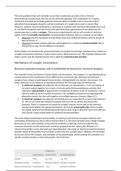The ionic gradients that cells maintain across their membranes provide a form of stored
electrochemical energy that cells can use for electrical signaling. The combination of a resting
membrane potential and voltage-gated ion channels allows excitable cells to generate action
potentials that propagate along the surface membrane of a single nerve axon or muscle fiber.
However, another class of mechanisms is necessary to transmit such electrical information from cell
to cell. Electrical signals must pass across the specialized gap region between two apposing cell
membranes that is called a synapse. The process underlying this cell-to-cell transfer of electrical
signals is termed synaptic transmission. Communication between cells at a synapse can be either:
electrical (electrical synapses provide direct electrical continuity between cells by means of
gap junctions), or
chemical (chemical synapses link two cells together by a chemical neurotransmitter that is
released from one cell and diffuses to another)
In this chapter we introduce the general principles of synaptic transmission and then focus mainly on
synaptic transmission between a motor neuron and a skeletal muscle cell. This interface between the
motor neuron and the skeletal muscle cell is called the neuromuscular junction.
Mechanisms of synaptic transmission
Electrical continuity between cells is established by electrical or chemical synapses
The essential structural element of intercellular communication, the synapse, is a specialized point of
contact between the membranes of two different but connected cells. Electrical and chemical
synapses have unique morphological characteristics, distinguishable by electron microscopy. One
major distinction is the distance of separation between the two apposing cell membranes:
At electrical synapses, the adjacent cell membranes are separated by ~3 nm and appear to
be nearly sealed together by a cluster of closely packed intramembranous particles that
represent a gap junction. A gap junction corresponds to planar arrays of connexons, each of
which is made up of six connexin monomers. The multiple connexons from apposing cells
physically connect the two cells together via multiple aqueous channels (figure 8.1).
At chemical synapses, the adjacent cell membranes are separated by a much larger distance
of ~30 nm (at a neuronal chemical synapse) and up to 50 nm (at the neuromuscular
junction). There is a presence of numerous synaptic vesicles on the side of the chemical
synapse that initiates the signal transmission, termed the presynaptic side. These vesicles
are sealed, spherical membrane-bound structures that range in diameter from 40 to 200 nm
and contain a high concentration of chemical neurotransmitter.
The contrasting morphological characteristics of electrical and chemical synapses underline the
contrasting mechanisms by which they function (table 8.1). Electrical synapses pass voltage changes
directly from one cell to another across the low-resistance continuity that is provided by the
connexon channels. On the other hand, chemical synapses link two cells by the diffusion of a
chemical transmitter across the large gap separating them. Key steps in chemical neurotransmission
include release of transmitter from synaptic vesicles into the synaptic space, diffusion of transmitter
across the cleft of the synapse, and activation of the postsynaptic cell by binding of transmitter to a
specific receptor protein on the postsynaptic cell membrane.
1
,Table 8.1. Summary of properties of electrical and chemical synapses.
Electrical synapses directly link the cytoplasm of adjacent cells
Electrical synapses exhibit no time delay in transmission of an electrical signal. In contrast, chemical
synapses exhibit a characteristic delay of ~1 ms in the postsynaptic voltage signal after excitation of
the presynaptic cell. The demonstration of an electrical synapse between two nerve membranes
highlighted an important functional difference between electrical and chemical synapses which is the
immediate signal propagation (electrical) versus briefly delayed communication (chemical) via the
junction.
An electrical synapse is a true structural connection formed by connexon channels of gap junctions
that link the cytoplasm of two cells (figure 8.2). These channels thus provide a low-resistance path for
electrotonic current flow and allow voltage signals to flow with little attenuation and no delay
between two or more coupled cells. Many types of gap junctions pass electrical current with equal
efficiency in both directions—these are termed reciprocal synapses. In other words, the current
passing through the gap junction is ohmic; it varies linearly with the transjunctional voltage (i.e.,
the Vm difference between the two cells). However, electrical synapses that allow electrical current to
pass readily in only one direction are called rectifying synapses, to indicate that the underlying
junctional conductance is voltage dependent. Studies of cloned and expressed connexins have shown
that the voltage dependence of electrical synapses arises from unique gating properties of different
connexin isoforms. Some isoforms are voltage dependent; others are voltage independent. Intrinsic
rectification can also be altered by the formation of a gap junction that is composed of two
hemichannels, each made up of a different connexin monomer. Such hybrid connexins are called
heterotypic channels.
Figure 8.1. Gap junction channels. Connexins, connexons, and
gap junction channels in apposing membranes.
2
, Figure 8.2. An electrical synapse. An electrical synapse
consists of one or more gap junction channels
permeable to small ions and molecules (see figure 8.1).
Chemical synapses use neurotransmitters to provide electrical continuity between
adjacent cells
By their very nature, chemical synapses are inherently rectifying or polarized. They propagate current
in one direction: from the presynaptic cell that releases the transmitter to the postsynaptic cell that
contains the receptors that recognize and bind the transmitter. However, the essentially
unidirectional nature of chemical synaptic transmission belies the possibility that the postsynaptic
cell can influence synapse formation or transmitter release by the presynaptic cell. Studies of synapse
development and regulation have shown that postsynaptic cells also play an active role in synapse
formation. In the CNS, postsynaptic cells may also produce retrograde signaling molecules, (e.g., such
as nitric oxide), that diffuse back into the presynaptic terminal and modulate the strength of the
synaptic connection. Furthermore, the presynaptic membrane at many synapses has receptors that
may either inhibit or facilitate the release of transmitter. Thus, chemical synapses should be
considered a unidirectional pathway for signal propagation that can be modulated by bidirectional
chemical communication between two interacting cells.
The process of chemical transmission can be summarized by the following series of steps:
Step 1: Neurotransmitter molecules are packaged into synaptic vesicles. Vesicular transporters
concentrate neurotransmitters inside the vesicle using the energy of an H + electrochemical
gradient.
Step 2: An action potential, which involves voltage-gated Na + and K+ channels, arrives at the
presynaptic nerve terminal.
Step 3: Depolarization opens voltage-gated Ca 2+ channels, which allows Ca2+ to enter the presynaptic
terminal.
Step 4: The increase in intracellular Ca2+ concentration ([Ca2+] i ) triggers the fusion of synaptic vesicles
with the presynaptic membrane. As a result, packets (quanta) of transmitter molecules are
released into the synaptic cleft.
3





